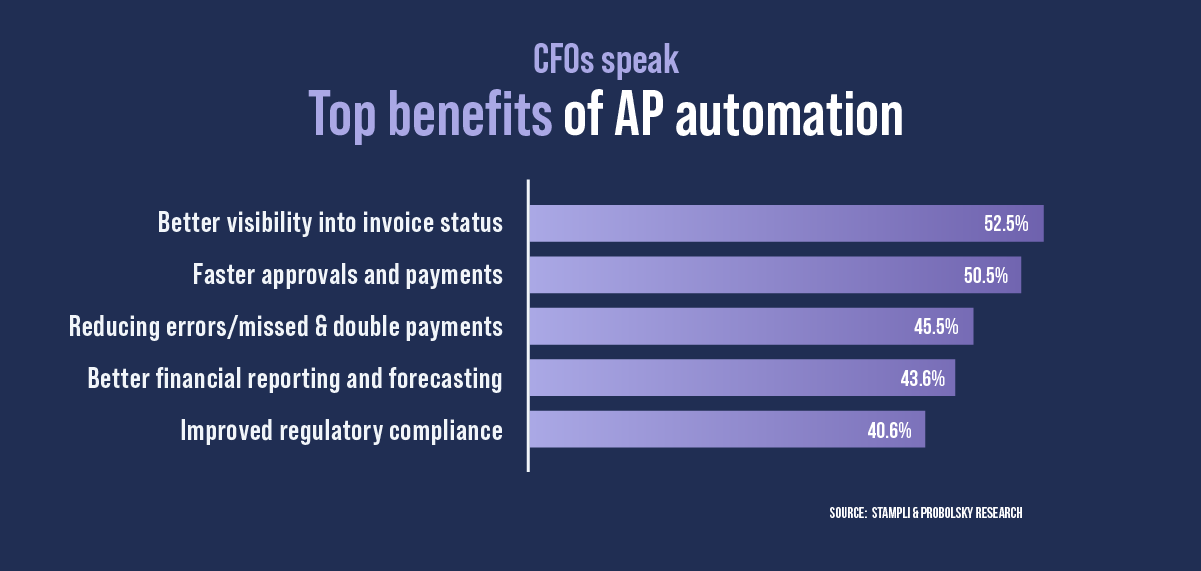Days payable outstanding: How to calculate accounts payable days

Effective cash flow management is essential for any business. Accounts payable days, or Days Payable Outstanding (DPO), track the average time a company takes to pay supplier invoices. It’s a key metric that provides valuable insights into accounts payable (AP) efficiency.
Many businesses struggle with inefficient AP processing. They’re held back by slow and error-prone manual or partially automated processes, coupled with sluggish and glitchy ERP integrations and limited data visibility. As a result, they’re often late paying vendors, which damages supplier relationships. It also keeps them from strategically managing cash flow, leading to cash shortfalls and missed investment opportunities.
In this article, we’ll show you how to understand DPO and use its insights to streamline accounts payable and optimize cash flow management. We’ll show you how to calculate DPO, interpret what it says about your business, and explore strategies to manage it more effectively. Your business will be able to shift from reactive cash flow management to a proactive, strategic approach that ensures healthy cash flow and supports business growth.
What is AP days (DPO)?
As mentioned, Days Payable Outstanding measures the average number of days it takes a business to pay its suppliers within a specific accounting period. It can also be thought of as a measure of how long a business holds onto its cash by delaying paying invoices.
DPO is related to the accounts payable turnover ratio. This ratio measures how many times a year a company pays down its accounts payable.
Why is DPO important?
Calculating and interpreting DPO is one of the best ways to understand how well your accounts payable department is performing.
Knowing how fast your business pays invoices gives you insight into accounts payable performance and vendor relationships. For example, if your business is paying invoices on time, it’s a sign your AP team is working efficiently and vendors are (probably) happy. If your business is chronically late making payments, it’s a sign there’s a problem with your AP and your vendor relationships may be at risk.
Tracking DPO helps your business identify bottlenecks in your accounts payable processes and understand payment trends. Armed with this information, you can improve AP workflows and make more informed cash management decisions to pay vendors on time and maintain healthy cash flow.
How to calculate the AP days formula
To calculate the AP days or DPO for a period, we divide the average accounts payable by the cost of goods sold (COGS) and multiply by the number of days in the period.
![Formula for Days payable outstanding [DPO] which equals the average AP balance for a period divided by the cost of goods sold for the period, multiplied by the number of days in a period](https://www.stampli.com/wp-content/uploads/2024/06/02-Days-payable-outstanding.png)
The data to calculate DPO can be found on the balance sheet, general ledger, or other financial records.
To calculate the average accounts payable balance, add the beginning and ending accounts payable balances for the period and divide the sum by two.
To calculate the cost of goods sold, add the beginning inventory and purchases in the period, and subtract the ending inventory.
There are two versions of DPO. The first version calculates the DPO using the average accounts payable over a specified period, such as a year, quarter, or month. The second version calculates the DPO for a specified period using the accounts payable balance at the end of the period. For example, to calculate the DPO for the quarter ending December 31, you’d divide the AP balance on December 31 by the COGS for the quarter and multiply by 90 days.
Example DPO calculation
BTB Technologies wants to calculate its DPO for its last quarter. Their beginning AP balance for the quarter was $3 million, and the ending AP balance was $4 million. During the quarter, their beginning inventory was $20 million, and they purchased $12 million in new inventory. Their ending inventory was $24 million.
Using these figures, we can calculate BTB’s average AP balance and cost of goods sold for the quarter as:
AP balance = ($3 million + $4 million)/2 = $3.5 million
Cost of goods sold = ($20 million + 12 million – $24 million) = $8 million
Then we can calculate BTB’s DPO for the quarter:
DPO = $3.5 million/$8 million X 90 days = 39.3 days
This means that in the quarter, BTB paid its suppliers within an average of 39 days.
How to interpret DPO trends
By tracking DPO over time, you can identify trends in how your business manages cash and pays vendors. You can also compare DPO to other financial metrics to gain deeper insights into your company’s financial health.
Let’s look at some ways you can interpret DPO trends.
High or increasing DPO
A high or increasing DPO means it is taking longer to pay suppliers. This could be a sign the business is managing its cash strategically by using available cash for short-term investments. However, if the DPO is consistently higher than vendors’ credit terms, it could mean the business is risking damaging relationships with vendors. For example, if a company’s vendors offer net 30 credit terms and its DPO is 45, the business always pays its bills 15 days late. If the situation isn’t addressed, the vendors could refuse to extend trade credit in the future.
Increasing DPO over time can also indicate a business is having trouble meeting its financial obligations. Investigating the revenue side of the business may provide further insights.
Low or decreasing DPO
A low DPO is a sign a business is paying vendors early or on time. This could suggest that the business has efficient AP processes and is managing cash flow effectively. However, it could also indicate the business isn’t taking advantage of early payment discounts. It could also mean the business may be missing out on investment opportunities by paying its bills too quickly. For example, if the company’s vendors offer net 60 credit terms and its DPO is 30, the business could be investing the funds and earning returns for 30 days before payment is due.
DPO vs. Days sales outstanding (DSO)
Days sales outstanding (DSO) measures the average length of time for sales to be paid back to a business. Like DPO, DSO can be used to gauge the financial health of a company. If DSO is high, it means the company is taking a long time to collect its accounts receivable. A high DSO combined with a high DPO could be a sign the business is short on cash and having trouble meeting its obligations.
A low DSO indicates the company is collecting its accounts receivable quickly. A low DSO combined with a low DPO could indicate the business is cash-rich and paying its suppliers quickly. Conversely, a low DSO combined with a high DPO could indicate the business is cash-rich, but is being more strategic by paying its vendors later and reinvesting the extra funds.
DPO vs payment terms
Comparing DPO to a company’s supplier payment terms can reveal much about its cash management and financial health. For example, if a company has net 30 payment terms and a DPO of 60, it is paying vendors 30 days late and may be incurring late payment penalties. This is often a sign a business is cash poor and struggling to make payments. Alternatively, a company with net 90 payment terms that has a DPO of 30 is paying bills 60 days early. This could be a sign the company has elected to pay vendors early to maintain positive vendor relationships. However, it could also mean the company is not managing its cash optimally — by paying vendors 60 days early it could be forgoing investment opportunities.
How to optimize accounts payable days
DPO provides a great guideline for optimizing accounts payable workflows and cash flow management. By streamlining your AP processes you’ll gain more control over your payment schedule. You’ll be able to pay vendors on time and better manage cash flow.
Here are a few strategies to optimize DPO at your business.
Optimize inventory management
DPO is closely tied to how well your business manages inventories. Inventory overstocks and shortfalls can make it difficult to forecast your purchasing needs, which can play havoc with cash flow. Optimizing your inventory management makes it easier to forecast inventory levels, letting you plan purchases and make more regular orders — which makes it easier to manage cash flow and pay vendors on time.
Take advantage of credit
You can take advantage of credit to pay suppliers faster and lower your DPO. However, this should only be a short-term strategy because borrowing can cause future cash shortages and higher interest charges if your business can’t repay the credit quickly. In the long term, improving AP processing efficiency is a better way to control DPO and manage cash flow.
Negotiate favorable payment terms with suppliers
Negotiating better credit terms with suppliers can give you more time to make payments, especially if your DPO is consistently high. Alternatively, if you consistently pay vendors early, you should negotiate early payment discounts to help reduce costs.
Leverage accounts payable automation
Automating your accounts payable process streamlines invoice processing and lets you pay suppliers faster. Leading financial automation solutions like Stampli go beyond streamlining invoice processing to provide seamless ERP integration, actionable data reporting and analytics, and fast electronic payment methods. They give finance leaders total visibility into AP performance and invoice and payment status — and complete control over cash flow management.

How to control DPO with financial automation software
You can use financial automation software to optimize invoice and payment processing and pay vendors faster. Leading solutions also offer real-time data reporting and analytics features that give you accurate, actionable data on invoice status, AP performance, and payment processing. Using these insights you can strategically manage vendor payments to take advantage of favorable credit terms and early discounts.
Here’s how you can use financial automation to optimize AP processing.
Make informed decisions using accurate invoice status data
Leading AP automation solutions feature reporting and analytics capabilities and use visual dashboards to make AP data clear and easy to understand.
Pay vendors sooner with fast approvals and payment processing
AP automation speeds up payments by routing invoices to the correct approvers and sending reminders to keep things moving along. Solutions with integrated payment processing let you take advantage of electronic payment options to quickly pay invoices after they’re approved.
Improve vendor relationships by eliminating errors and missed payments
Avoid missed or late payments by reducing processing errors and unnecessary delays. AP automation eliminates error-prone manual tasks that can slow down invoice processing and lets you pay vendors on time.
Build collaboration with seamless ERP integration
The best financial automation systems provide seamless integration with ERPs and accounting systems. By syncing data and communications in real time, integration ensures everyone in your organization is working from the same data.
By implementing a leading financial automation platform like Stampli, you can take a proactive rather than reactive approach to managing cash flow and reducing DPO. Other financial automation platforms include limited AP functionality. Stampli is designed for how accounts payable departments actually work. It’s the smartest and fastest way to optimize AP processing and strategically manage cash flow.
Stampli “is a tool that has moved our company forward in both technology and increased productivity,” says one TrustRadius reviewer. “We process thousands of invoices monthly without hiccups, and it has cut down on employees having to request information from the finance dept. as they are able to pull up any invoices that have been placed in their queue to see the status or get a copy if needed.
“…You can break down the time it is taking employees to approve their invoice and find any bottlenecks in the process. Stampli is a wonderful tool and we are very happy that we chose to implement it in our department!
“With Stampli, we have decreased our days to process by over 3 days!!”
Case study: Faster invoice turnover for Family Allergy & Asthma
Family Allergy & Asthma provides a full range of allergy, asthma, immunology, and sleep medicine services to patients in Kentucky, Indiana, Ohio, and Tennessee. They work with a diverse group of vendors like immunotherapy drug manufacturers, medical suppliers, and office supply companies.

Their transactions are non-PO-based. Each department orders directly with vendors, a procurement structure that controller Zach Kulow said gave them no insight into their AP pipeline. “We had no visibility into invoices until the order arrived,” said Zach. “Our accountant hand-coded each invoice and managed approvals among three to four people.”
Family Allergy & Asthma wanted a solution that would integrate with its Sage Intacct ERP to shorten the invoice cycle and give them visibility into their AP processes.
Zach and his team evaluated Tipalti and Hybrent before choosing Stampli. They needed an AP solution that could address their urgent need for processing and invoice approval automation while letting them use their existing payment processes. Stampli’s built-for-AP design made the choice clear. According to Zach: “Most of the AP automation vendor tools center around bill payment, and the AP side was not as robust. When we found that Stampli did exactly what we wanted, it was the obvious choice.”
With integration support from Stampli’s team, Zach’s team implemented Stampli in a single day and trained 15 approvers on the new system. The results were spectacular: after implementing Stampli, Zach’s team shortened their invoice processing time from 10 to 3 days, a 70% reduction. They were also able to move invoices into Sage Intacct 90% faster.
According to Zach the biggest benefit from implementing Stampli was getting more visibility into the invoice approval process. “The flexible approval workflow in Stampli is very valuable, as we get responses from approvers much faster. We can easily and quickly identify who has what invoice and its status in the approval process.”
By giving Family Asthma & Allergy visibility and control over their invoice processing, Stampli helped them pay vendors faster and reduce their DPO. Implementing Stampli has also helped them improve cash flow management by giving them full visibility over the invoice approval and payment process.
Stampli: financial automation for strategic cash flow management
Stampli is an ideal choice for improving how your business manages cash flow.
AP teams are under increasing pressure to reduce costs and invoice processing time to help companies better manage their short-term liquidity and cash flow. Stampli offers the expertise, experience, and resources to optimize AP processing and improve working capital management.
Stampli’s solution is “Slick software that greatly improves my visibility,” according to one CFO. “I now feel like I have significantly greater visibility over the state of payables and can much better monitor the work of my AP team. I can plan cash flow better with the payment functionality by scheduling payments in the future…This reduces double or even triple entering of data into our ERP and our banking system by integrating payments with payables.”
Take control of your AP processes and optimize cash flow. Contact a Stampli expert today for a free demo.